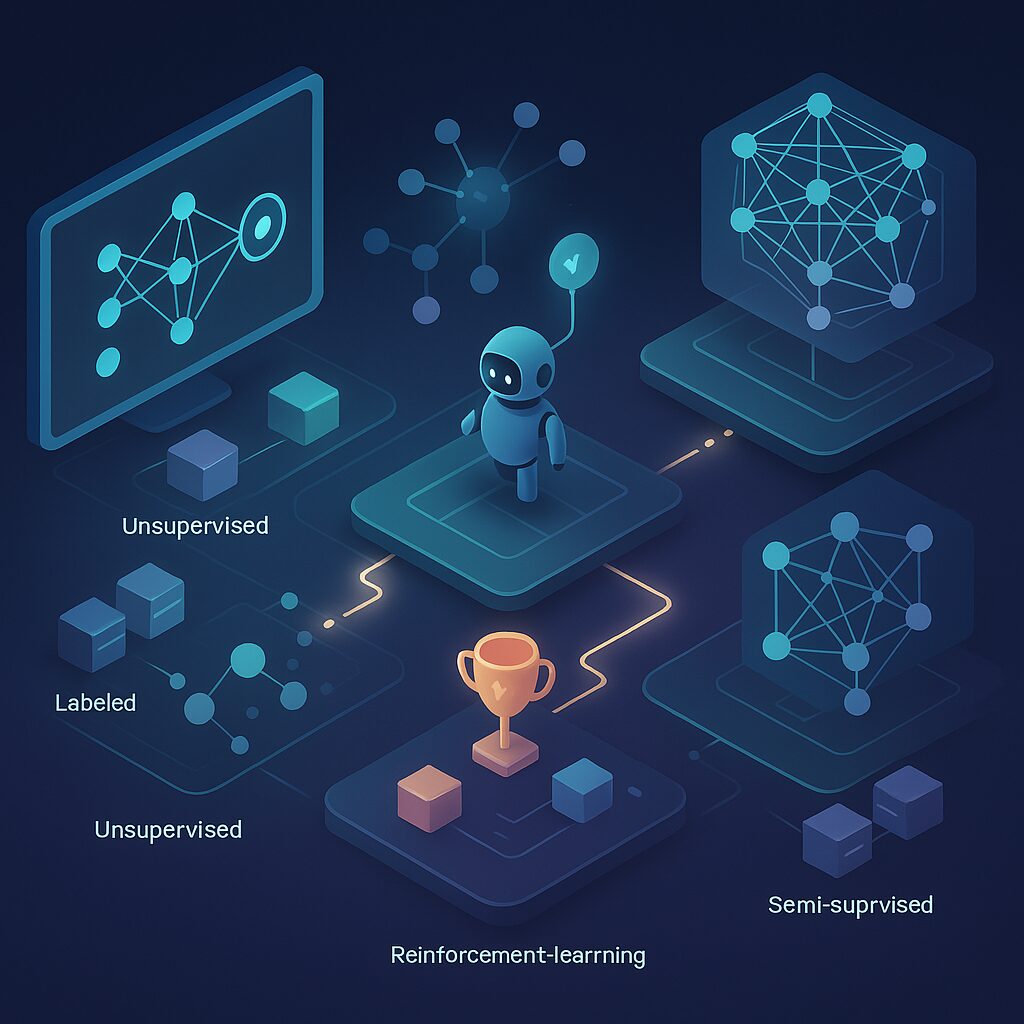Introduction
Selecting the right type of machine learning (ML) is critical for AI Solutions Managers aiming to align technological capabilities with specific business objectives. Each ML type—Supervised, Unsupervised, Reinforcement, Self-Supervised, and Semi-Supervised—offers distinct strategic benefits and limitations. This guide provides clarity on when and how to leverage each ML approach effectively within your organization’s AI initiatives.
Supervised Learning: Precision Through Clarity
Supervised learning leverages clearly labeled datasets to teach algorithms how to predict outcomes accurately. Real-world applications include fraud detection in banking, asset failure predictions in manufacturing, and targeted marketing campaigns. Common algorithms are Logistic Regression, XGBoost, and Support Vector Machines (SVM).
-
Strengths: High accuracy, especially when ample labeled data exists; clearly interpretable results.
-
Weaknesses: Requires extensive labeling, expensive data preparation.
-
Strategic Use: Choose supervised learning when accuracy and predictability are paramount and labeled historical data is available. Ideal for regulatory compliance scenarios or risk-sensitive applications.
Unsupervised Learning: Discovering Hidden Patterns
Unsupervised learning analyzes unlabeled data to identify intrinsic structures and patterns. Applications range from customer segmentation in marketing to anomaly detection in cybersecurity and financial auditing. Typical algorithms include K-Means clustering, DBSCAN, and Principal Component Analysis (PCA).
-
Strengths: Ideal for exploratory analysis; requires no labeling; adaptable to unknown scenarios.
-
Weaknesses: Results can be ambiguous, requiring skilled interpretation.
-
Strategic Use: Opt for unsupervised learning in situations where data labeling is impractical, or when initial data insights are needed to frame future supervised models or strategic business decisions.
Reinforcement Learning: Dynamic Decision-Making
Reinforcement learning involves algorithms learning optimal decisions through trial-and-error and reward-based feedback loops. Key use cases include autonomous driving, robotics, and recommendation systems that adapt based on user interactions. Algorithms like Q-learning and Deep Q-Networks (DQN) are most commonly used.
-
Strengths: Effective in dynamic, continuously evolving environments; capable of adaptive improvement over time.
-
Weaknesses: High computational complexity; slow initial training phases.
-
Strategic Use: Implement reinforcement learning when developing systems requiring continuous adaptation, such as real-time customer engagement or automated operational control systems.
Self-Supervised Learning: Efficient Label Generation
Self-supervised learning generates internal labels from raw data itself, eliminating the dependency on external labeling efforts. This is widely used for foundational models, embeddings, and language modeling. Algorithms include Contrastive Learning and Autoencoders.
-
Strengths: Reduces reliance on manual labeling; effective with large-scale data sets.
-
Weaknesses: Limited to scenarios where meaningful internal labels can be generated naturally.
-
Strategic Use: Deploy self-supervised learning when managing massive datasets, especially in natural language processing (NLP) or initial feature extraction stages of complex systems.
Semi-Supervised Learning: Maximizing Limited Data
Semi-supervised learning blends limited labeled data with abundant unlabeled data, particularly useful in specialized fields like medical imaging diagnostics and compliance scoring. Algorithms typically integrate supervised and unsupervised methods, enhancing model accuracy without exhaustive labeling.
-
Strengths: Maximizes the value from limited labeled datasets; lowers labeling costs significantly.
-
Weaknesses: Quality highly dependent on labeled data accuracy; careful management of biases required.
-
Strategic Use: Choose semi-supervised learning when faced with high labeling costs or time constraints, especially in healthcare, financial compliance, and niche market analysis.
Summary Matrix: Strategic ML Selection
| ML Type | Data Requirements | Strength | Weakness | Ideal Use Case |
|---|---|---|---|---|
| Supervised | Fully labeled data | High accuracy | High labeling cost | Regulatory compliance, fraud detection |
| Unsupervised | Unlabeled data | Exploratory insights | Ambiguous outputs | Customer segmentation, anomaly detection |
| Reinforcement | Dynamic environment | Adaptability | Computationally intensive | Robotics, recommendation engines |
| Self-Supervised | Large-scale unlabeled | Cost-efficient labeling | Requires meaningful internal signals | NLP, embeddings |
| Semi-Supervised | Few labeled data points | Cost-effective, accurate | Sensitive to labeled data quality | Medical imaging, compliance scoring |
Conclusion
Understanding and strategically selecting the appropriate type of machine learning is vital for AI Solutions Managers aiming to maximize business impact. By aligning ML types clearly with data availability and business objectives, managers can effectively leverage AI, ensuring robust, scalable solutions that deliver measurable outcomes and sustained competitive advantage.

